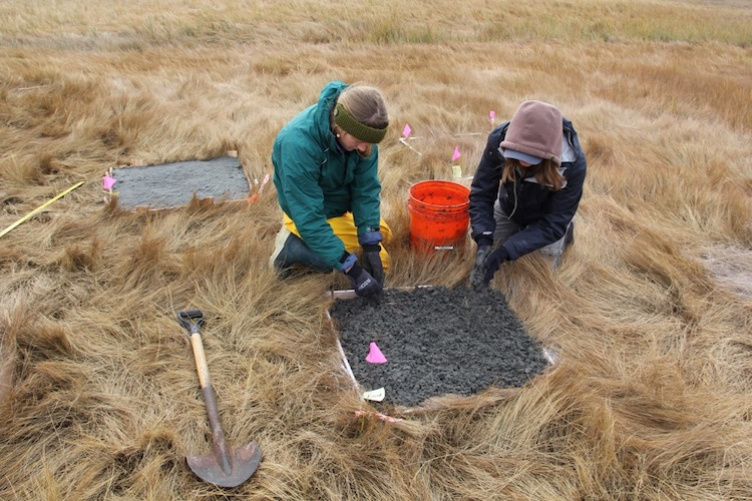
UNH students conducting a field experiment on an area salt marsh.
There is a large section of salt marsh along Crommet Creek in Durham, New Hampshire, that doesn’t look the same anymore. What was once a productive stand of lush marsh grass is now a barren mudflat. The change is a symptom of the degradation of coastal wetlands taking place across the country due to accelerated flooding and sea level rise.
For the next two years, as part of a federal grant to the Rhode Island Department of Environmental Management, UNH’s Gregg Moore and David Burdick will be among a group of researchers conducting a study on how to lessen the decline by boosting salt marsh resistance. Led by the Narragansett Bay National Estuarine Research Reserve, the $500,000 grant will help evaluate the use of thin layer sediment placement as an adaptation strategy at eight other national reserves. Burdick and Moore will work closely with Rachel Stevens, stewardship coordinator and wildlife ecologist with the Great Bay National Estuarine Research Reserve here in New Hampshire.
“We all recognize the same problems,” says Moore, an associate research professor at the Jackson Estuarine Laboratory in Durham. “UNH has one of the few research teams that has designed and implemented field experiments testing this technique, so we’re glad to be doing this work together with the other research reserves.”
“In places like Crommet Creek, it’s like walking through a big bowl of chocolate pudding.”
All of the researchers will conduct the same experiment and follow the same protocol, using the same treatment types, monitoring parameters and numbers of samples. At UNH, that will involve setting up a series of plots in the marsh at Adams Point, where the Jackson Estuarine Laboratory is located. A thin layer of sediment, contained within small, wooden boxes, will be added to the marsh. Control containers won’t have anything added. The plots will be monitored in hopes that the sediment layers will help increase the marsh plain elevation.
New Hampshire has about 7,500 acres of estuarine and marine wetlands along its short coastline.
“The idea of using a layer of sediment is that at a certain level it will promote growth in the marsh instead of smothering it,” says Moore, who is also academic coordinator for the Shoals Marine Laboratory. “It has to be the right amount or you won’t have marsh anymore. A thin layer will help the marsh build resilience for itself.”
The sediment study is designed to eliminate speculation and determine whether it is a viable option for restoring salt marshes, which in addition to protecting coastlines from erosion, slow down the incoming and outgoing tides, improving water quality. Salt marshes also are critical to the function of the ecosystem, providing food for crustaceans, insects and fish and foraging habitats for wading birds.
There are areas in New Hampshire and other parts of the country where salt marshes ability to adapt can no longer keep pace with the impact of rapidly rising sea levels. UNH’s field study site is one that appears to be suffering from effects of excessive flooding.
“In places like Crommet Creek, it’s like walking through a big bowl of chocolate pudding,” Moore says of changes to the marsh. “Whether it’s because of accelerated flooding or sea rise, it doesn’t matter. Regardless of the cause, the marsh is drowning.”
The collaborative project, titled “Thin-layer sediment placement: evaluating an adaptation strategy to enhance coastal marsh resilience across the NERRS,” will allow researchers to assess the value of the technique locally as well as compare the results of their work to those of study partners across the country.
“Most of what we know about building marsh using thin layer deposition comes from Louisiana,” says Burdick, interim Jackson Lab director, who recently completed a review of the science on the technique. “We really need information from around the country to determine its value to marshes in different regions.”
Find out more about UNH's School of Marine Science and Ocean Engineering.
-
Written By:
Jody Record ’95 | Communications and Public Affairs | jody.record@unh.edu



















































